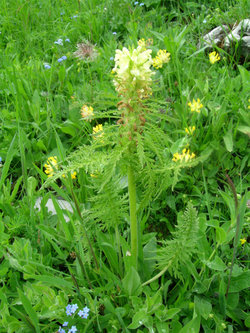Pedicularis
If this plant info box on watering; zones; height; etc. is mostly empty you can click on the edit tab and fill in the blanks!
Pedicularis is a genus of perennial green root parasite plants belonging to the broomrape family Orobanchaceae. Between 350-600 species are accepted by different authorities, mostly from the wetter northern temperate zones, as well as from South America. The highest diversity is in eastern Asia, with 352 species accepted in China alone by the Flora of China (not detailed here; see external links for details).
The common name lousewort, applied to several species, derives from an old belief that these plants, when ingested, were responsible for lice infestations in stock.
Read about Pedicularis in the Standard Cyclopedia of Horticulture
|
|---|
|
Pedicularis (from Latin for louse; application not evident). Scrophulariaceae. Louse Wort. Herbs, mostly perennial, sometimes planted in grounds for the showy spikes of flowers and often finely cut foliage. Mostly erect,only seldom annual or beinnial: lvs. alternate or whorled (sometimes opposite), rarely sub- opposite, 1 to many times pinnately divided, rarely merely dentate: fls. purplish, red, rose-color to white, in spring and summer, borne mostly in a terminal bracted spike; calyx anteriorly cut, variously 2-5- toothed, sometimes also posteriorly; corolla 2-lipped, the upper one (or galea) with or without a long beak, the tube cylindrical; stamens 4, didynamous: caps, ovate or lanceolate, oblique; seeds usually few.—There are about 250 species of Pedicularis in many parts of the northern hemisphere (a few S. American), many of them arctic and alpine. Thirty to 40 are native in the U. S., and the genus has a large extension in Asia. They are little known as garden plants, not being really domesticated. Some of them are adaptable to banks and borders, and others to rock-gardens and alpine work; some are swamp plants. They are likely not to persist long without renewal, as they appear to be partially parasitic and may require a particular host plant. Prop, by seeds and division. The following American species are perennial. P. curvipes, Hook. f. Sts. 1 ft. long, very slender and curving: lvs. far apart, 1 in. or less long. pinnatifid, the lobes 3 or 4 pairs and incised: fls. rose-colored, axillary, long-pedicelled, the stalks recurving in fr. Himalaya, 10,000 ft. —P. foliosa. Linn. Sts. simple, 1-3 ft.: lvs. pinnatifid, the segms. lanceolate and toothed: fls. cream-color, in a dense spike; galea very blunt. Eu.—P. mollis, Wall. Annual, 2-3 ft., strict: lvs. all on the St., ovate or oblong, pinnatifid, the segms. linear and crenate or pinnatifid: fls. dark pinkish purple, in strict spikes 6-16 in. long. Himalaya, Thibet, 10,000-14,000 ft.— P. Sceptrum-Carolinum, Linn. St. few-lvd., 3—4 ft.: lvs. pinnatifid, the lobes ovate and crenulate: fls. golden yellow, 1 in. long, in an interrupted spike, the lower lip tinged red. Eu. —P.siphonantha, Don. Sts. 1 ft. high or less, erect or ascending: lvs. raaical, linear-oblong, pinnatifid: fls. red or pink, axillary and in terminal racemes, the corolla-tube 1-6 times as long as calyx. Afghanistan to Tibet. CH
|
Cultivation
- Do you have cultivation info on this plant? Edit this section!
Propagation
Usually propagated from seed, as translating, cloning and other means of propagation have proven difficult.
Pests and diseases
- Do you have pest and disease info on this plant? Edit this section!
Species
- Selected species
- Pedicularis acaulis
- Pedicularis amoena
- Pedicularis arguteserrata
- Pedicularis ascendens
- Pedicularis asparagoides
- Pedicularis asplenifolia
- Pedicularis attollens
- Pedicularis baumgartenii
- Pedicularis brachyodonta
- Pedicularis bracteosa (Fern-leaf, Towering, or Bracted Lousewort)
- Pedicularis canadensis (Canadian Lousewort)
- Pedicularis centranthera
- Pedicularis comosa
- Pedicularis compacta
- Pedicularis contorta (Coiled Lousewort or White-coiled Beak Lousewort)
- Pedicularis dasyantha (Woolly Lousewort)
- Pedicularis dasystachys
- Pedicularis densiflora (Indian Warrior)
- Pedicularis dudleyi (Dudley's Lousewort)[1]
- Pedicularis elegans
- Pedicularis elongata
- Pedicularis exaltata
- Pedicularis ferdinandi
- Pedicularis flammea (Redrattle)
- Pedicularis foliosa (Leafy Lousewort)
- Pedicularis furbishiae (Furbish's Lousewort)
- Pedicularis friderici-augusti
- Pedicularis graeca
- Pedicularis groenlandica (Elephant's Head)
- Pedicularis gyroflexa
- Pedicularis hacquetii
- Pedicularis heterodonta
- Pedicularis hirsuta (Hairy Lousewort)
- Pedicularis howellii
- Pedicularis julica
- Pedicularis kaufmannii
- Pedicularis kerneri
- Pedicularis labradorica
- Pedicularis lapponica (Lapland Lousewort)
- Pedicularis leucodon
- Pedicularis limnogena
- Pedicularis mixta
- Pedicularis oederi (Crimson-tipped Lousewort)
- Pedicularis ornithorhyncha (Ducksbill Lousewort)
- Pedicularis orthantha
- Pedicularis palustris (Marsh Lousewort)
- Pedicularis petiolaris
- Pedicularis physocalyx
- Pedicularis portenschlagii
- Pedicularis procera (Giant Lousewort)
- Pedicularis pyrenaica
- Pedicularis racemosa (Parrot's Beak)
- Pedicularis recutita
- Pedicularis resupinata
- Pedicularis rosea
- Pedicularis rostratocapitata
- Pedicularis rostratospicata
- Pedicularis sceptrum-carolinum (Moor-king Lousewort)
- Pedicularis schizocalyx
- Pedicularis semibarbata
- Pedicularis sibthorpii
- Pedicularis sudetica
- Pedicularis sylvatica (Common Lousewort)
- Pedicularis tuberosa
- Pedicularis uralensis
- Pedicularis verticillata (Verticillate Lousewort)
Gallery
If you have a photo of this plant, please upload it! Plus, there may be other photos available for you to add.
References
- Standard Cyclopedia of Horticulture, by L. H. Bailey, MacMillan Co., 1963
External links
- w:Pedicularis. Some of the material on this page may be from Wikipedia, under the Creative Commons license.
- Pedicularis QR Code (Size 50, 100, 200, 500)

